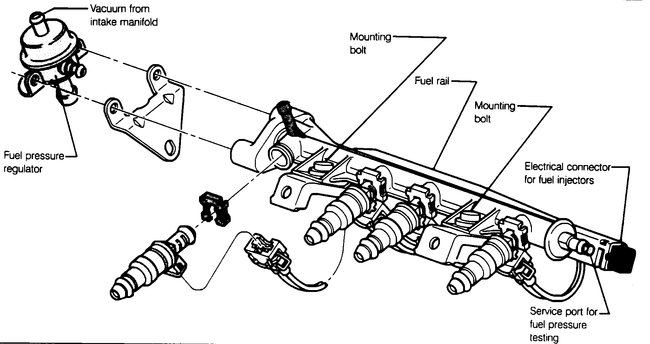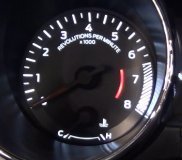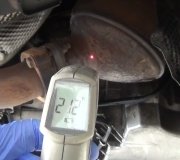Based on your description, it sounds like the fuel pump may be going bad or you may even have a plugged fuel filter. What I would do first is simply check fuel pressure.
Here is a link that explains how it is done:
https://www.2carpros.com/articles/how-to-check-fuel-system-pressure-and-regulator
Here are the directions specific to your vehicle for testing. The attached picture correlates with the directions.
1995 Volkswagen Golf III (1H1) L4-2.0L (ABA)
Fuel Pressure Test
Vehicle Powertrain Management Fuel Delivery and Air Induction Fuel Pump Fuel Pressure Testing and Inspection Component Tests and General Diagnostics Fuel Pressure Test
FUEL PRESSURE TEST
Although the quantity of fuel delivered to the engine is controlled primarily by how long the injectors are open, fuel pressure also has some influence. The fuel pressure created by the fuel pump is regulated by a diaphragm-type pressure regulator mounted to the end of the fuel rail.
A vacuum hose connected to the top of the regulator helps to control the fuel pressure as a function of engine vacuum. When the throttle is opened and vacuum drops suddenly, fuel pressure increases slightly to richen the air/fuel mixture for improved throttle response.
CAUTION: Cleanliness is essential when working with Motronic fuel system components. Before disconnecting any fuel lines, throughly clean the unions. Always use clean tools.
SYSTEM PRESSURE
System pressure is the pressure value which is maintained in the system by the fuel pressure regulator. When fuel pressure from the pump exceeds the desired system pressure, the regulator opens and routes excess fuel back to the fuel reservoir that surrounds the pump. System pressure is not adjustable and the pressure regulator should be replaced if it is faulty.
RESIDUAL PRESSURE
To avoid fuel vaporization and hard starting when the engine is hot, the system is designed so that fuel pressure is retained for a time after the engine has stopped running. This residual pressure is maintained by check valves in the pressure regulator and in the fuel pump. Neither the pressure regulator check valve nor the fuel pump check valve are serviceable as individual parts.
TO TEST FUEL PRESSURE
WARNING: Fuel will be expelled. Use a clean rag to soak up fuel. Do not disconnect any wires that could cause electrical sparks. Do not smoke or work near heaters or other fire hazards. Keep a fire extinguisher handy.
NOTE: The fuel pressure gauge must have a range of at least 0 to 50 psi (0 to 3.5 bar) and must be securely connected to prevent it from coming loose under pressure.
Digifant Fuel Delivery Components
pic 1
- Wrap the fuel rail with a clean rag, then loosen and remove the screw from the fuel rail service port and connect a fuel pressure gauge.
- START the engine and allow it to idle. Fuel system pressure should be:
Specification: 36 psi (2.5 bar)
- Disconnect the vacuum hose from the top of the fuel pressure regulator. Fuel pressure should increase to:
Specification: 44 psi (3.0 bar)
- Turn the engine OFF. After ten (10) minutes, residual pressure should be at least:
Specification: 29 psi (2.0 bar)
- If the system pressure is too high, the pressure regulator is faulty and should be replaced. If the pressure is too low, RUN the engine briefly to build up fuel pressure, then turn the engine OFF and quickly pinch shut the blue fuel return line. If the pressure holds, then the pressure regulator is faulty and should be replaced.
- If the pressure still drops, check for leaks in the fuel system. If no leaks are found, the fault may be due to a leaky fuel injector, a faulty fuel injector O-ring, or a faulty fuel pump check valve.
- To finish the fuel pressure test, disconnect the gauge from the fuel rail service port and catch any spilling fuel with a clean rag. Install the sealing screw with a new seal.
Start with this and let me know what you find. I will watch for your reply. Also, I realize most people don't own a fuel pressure gauge, but most parts stores will lend or rent one to you.
Take care,
Joe
Image (Click to make bigger)
Monday, January 6th, 2020 AT 8:42 PM



